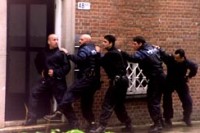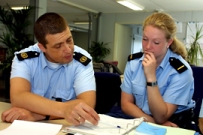Bringing Law and Order to the Dutch Police
![]() It
was their job to bring law and order to the streets of Holland. But that
wasn't the problem for the Dutch police force. The problem was the chaos
inside the police department.
It
was their job to bring law and order to the streets of Holland. But that
wasn't the problem for the Dutch police force. The problem was the chaos
inside the police department.
Our case study was part of a larger project to build a better-performing organization and to help the internal consultants who where in charge of this. The problem the police force had was resistance to change from the lower levels in the hierarchy. Management techniques were not working, and there was a growing tension between new officers and more experienced managers.
The main problem stemmed from
the use of managerial techniques "straight out of business school,"
which did not work inside the police force. It all began when the government
replaced part of their officers' training by sending the officers to local
business schools instead. The officers themselves were complaining that
the "managerial training" they had learned was hard to apply
in the police force. But why was it hard, and how could they fix it?
jobEQ was called by a consultant to help to analyse the organizational culture, so that the internal change agents could be briefed on how the cultural patterns of the organization we contributing to the problems. In this case, jobEQ's role was limited to the testing and diagnosis.
500 policemen for all areas in the country and of all ranks were randomly selected to complete the VSQ questionnaire. VSQ is the tool jobEQ uses to measure values and cultural fit. The test has an online format similar to the iWAM, but it measures factors that are more related to social interaction. These factors include how focused a person is on certain values, such as success or safety, and which social patterns they use, such as being left-brained or right-brained. Feedback reports from the test can be used to train employees to improve performance and relationships after a merger, a re-organization, a large recruitment campaign, or other situations where there is social tension within an organization.
With this sample, jobEQ was able to provide graphs, statistics, and feedback showing the main cultural influences in the 26 zones of the Dutch police force. We also looked for cultural differences between officers and lower ranked employees.
 We
found that the root of the problem boils down to the clash between different
value systems. The main value systems within the police organization had
evolved to green and yellow. In this case, we are using a color-coding
system to identify values (popularized by researchers Don Beck and Christopher
Cowan), where green and yellow signify a desire for change, learning,
integration of complex systems, and equality. The old style leadership,
however, was rather blue - valuing tradition, authority, and the greater
good. The new generation of officers was strongly influenced by main value
system taught in the business school, which is orange and correlates with
competition and autonomy.
We
found that the root of the problem boils down to the clash between different
value systems. The main value systems within the police organization had
evolved to green and yellow. In this case, we are using a color-coding
system to identify values (popularized by researchers Don Beck and Christopher
Cowan), where green and yellow signify a desire for change, learning,
integration of complex systems, and equality. The old style leadership,
however, was rather blue - valuing tradition, authority, and the greater
good. The new generation of officers was strongly influenced by main value
system taught in the business school, which is orange and correlates with
competition and autonomy.
Wow, three different sets of values. It's no wonder there was friction.
The conclusion was that the management needed coaching to adapt their management style to be more compatible with the management style which will fit their employees. As such, this is a similar cases as the one in the incentive ravel organization. Managers were taught how to ease change onto the traditional "blue" people, while the younger officers were coached to use their "orange" values in a way that would not conflict with the proper behaviors of a Dutch police officer. Overall, this was a case of competing job cultures, and how you can bring some law and order to the chaos.
Become a partner or client by joining jobEQ
Learn more about Modeling Organizational Cultures
Back to the overview of cases,
or continue to jobEQ's Hall of Fame
Recruitment Cases
- Narrowing a Huge Field of Job Applicants
- The High-Performing Sales Team
- Return on Investment
- Win-Win with a High-Volume Client
- Identifying Talent for a New Position
- Better Drivers... Lower Costs
- Easy Solutions for Simple Needs
Management Cases
Teambuilding Cases
- The Executives Get a Few Surprises
- Coaching to Improve Communications and Relationships
- Checking In to a Better Future
Cultural Change Cases
- Surviving Cultural Change with VSQ
- Bringing Law and Order to the Dutch Police
The three basic questions concerning actions are: What is the goal? How will you know you have reached it? What will you do to get there?
Other Pages
Join jobEQ
If you want results like these, then become one of our partners or clients!
Model of Excellence
Many of the case studies on this page involve using a Model of Excellence.
Find out if this method can be useful for your organization.

